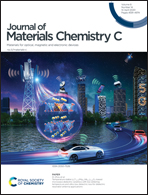Na3Sc2(PO4)2F3: rational design and synthesis of an alkali rare-earth phosphate fluoride as an ultraviolet nonlinear optical crystal with an enlarged birefringence†
Abstract
An alkali rare-earth phosphate fluoride nonlinear optical (NLO) crystal, Na3Sc2(PO4)2F3 (NSPOF), was designed and synthesized. The structure of NSPOF can be described as a three-dimensional (3D) framework assembled with a chessboard-shaped two-dimensional (2D) [Sc2P2O8F3]∞ layer and disordered Na+ cations in the cavities, possessing [PO4]3− tetrahedral groups and [ScO4F2] tetrahedral bipyramids as fundamental building blocks. With the introduction of Sc3+ and F− into the phosphate moiety, the NSPOF exhibited an obviously enlarged birefringence of 0.0978@546.1 nm, which is large enough for phase-matching (PM) in the UV region. In particular, the shortest PM wavelength calculated based on the calculated refractive index dispersion curve can reach 305 nm, which is shorter than those of most reported phosphates. The large birefringence can be attributed to the uniform alignment of [ScO4F2] tetrahedral bipyramids and the [PO4]3− tetrahedral groups. This work will provide a new avenue for the design and discovery of more phosphate NLO materials with large birefringence.



 Please wait while we load your content...
Please wait while we load your content...